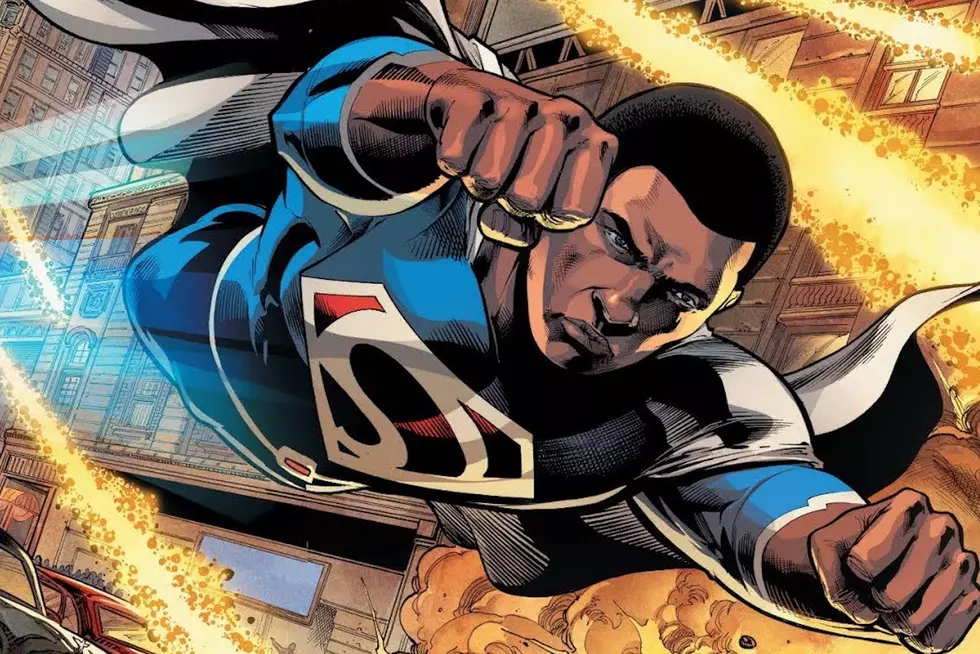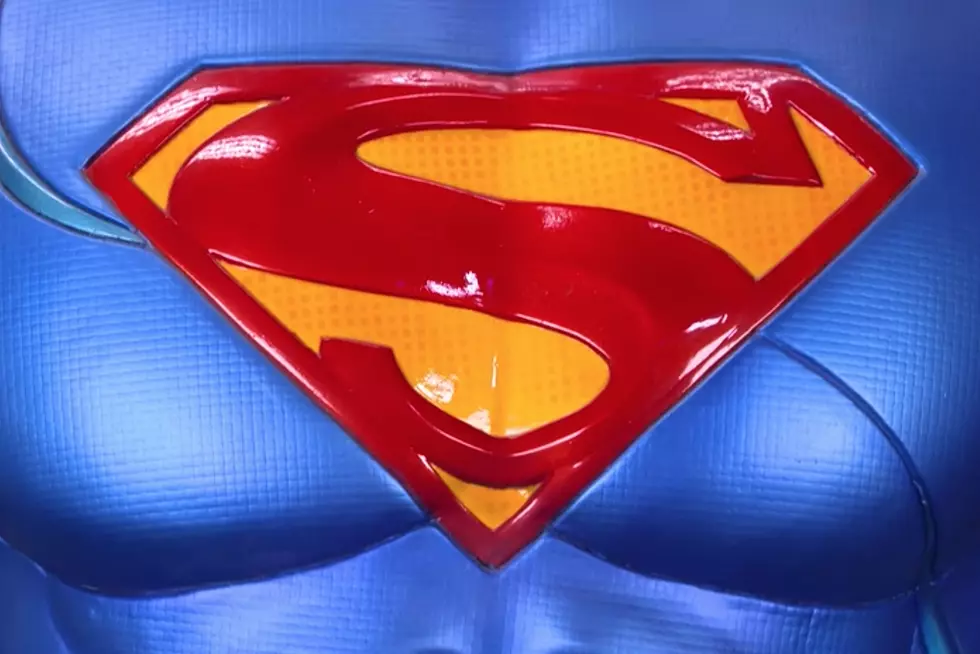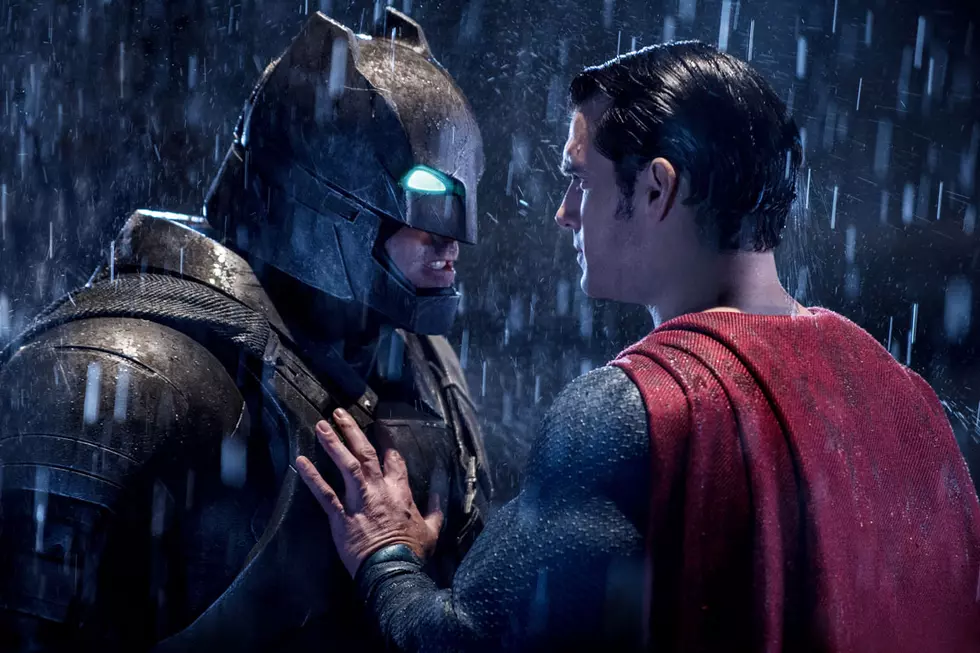
ComicsAlliance’s 20 Best Superman Panels
 When "Batman" #700 hit shelves two weeks ago, we here at ComicsAlliance decided to celebrate the Caped Crusader by offering up a list of my favorite Batman panels, Now, with "Superman" #700 released yesterday, it's the Man of Steel's turn!
When "Batman" #700 hit shelves two weeks ago, we here at ComicsAlliance decided to celebrate the Caped Crusader by offering up a list of my favorite Batman panels, Now, with "Superman" #700 released yesterday, it's the Man of Steel's turn!
Just like I did with Batman, I set aside some ground rules for myself at the start. First, they had to be actual story panels, not covers or pin-ups (meaning "Crisis on Infinite Earths" #7's famous pieta was out of the running). Second, I had to focus on individual panels, not sequences. And my third rule: Each panel had to have Superman himself, in costume.
That last one made things a little difficult. Not just because it meant I couldn't showcase the great scenes of Lex Luthor, Lois Lane and (my personal favorite) Jimmy Olsen, but because I'd removed Clark Kent, and I kept running across awesome shots of Superman's alter ego. His fake bumbling in "All Star Superman," his conversation with Pa in the first issue of "Man of Steel," I'd thrown 'em out the window. But in the end, everything came together, so while I might have a completely different list tomorrow, these are my picks for my 20 Favorite Superman Panels!
tweetmeme_url = 'http://comicsalliance.com/2010/06/28/best-superman-panels/'; tweetmeme_source = 'ComicsAlliance'; digg_url = 'http://digg.com/comics_animation/The_20_Best_Superman_Panels';
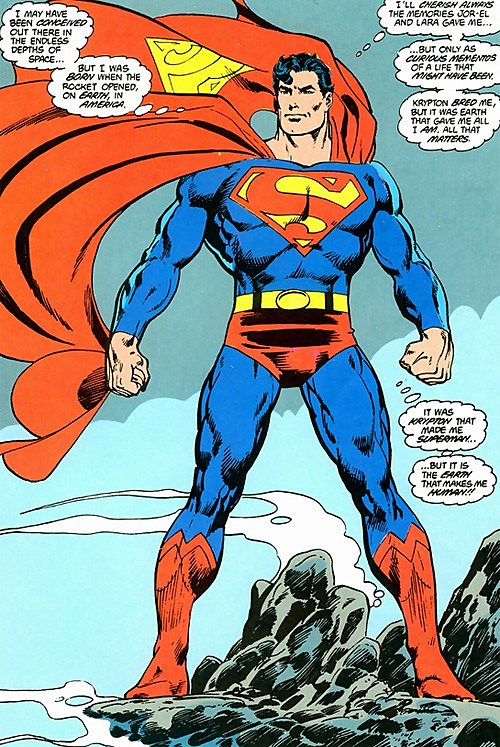
#20. John Byrne
From "The Man of Steel" #6
Back in 1986, writer/artist John Byrne was given the job of essentially rebuilding Superman from the ground up, and panels like the iconic shot above show just how well he got it. Not just in terms of the visuals, but in the words, where he boils down Superman's story to the incredibly important fact that he thinks of himself as one of us -- which at the time was a pretty big break from the Silver Age Superman's attitude.

#19. Frank Miller
From: "The Dark Knight Returns" #4
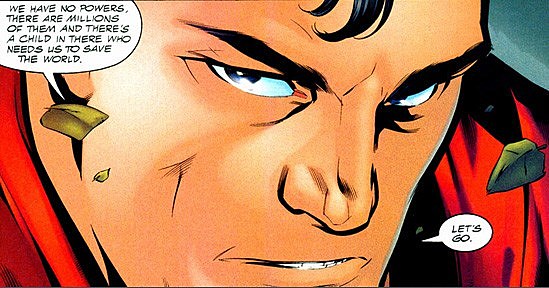
#18. Grant Morrison and Howard Porter
From: "JLA" #22
Speaking of guys who just get it, I'll warn you right now that you're going to be seeing a lot of Grant Morrison on this list. As a writer, he has an incredible talent for cutting to the core of what makes a character great that shows up time and time again with Superman. This time around, from the story where the JLA has to go into the world of dreams to fight Starro the Star Conqueror in order to save a boy who never lost his faith in heroes, he nails one of Superman's defining characteristics: The dude does not give up. Even without super-powers, what makes him a hero is the drive to do what's right.

#17. Garth Ennis and John McCrea
From: "JLA/Hitman" #2
It may surprise readers who aren't familiar with the issue to learn that the single best Superman story of the '90s was not only in someone else's book, but that it was written by Garth Ennis: "Hitman" #34. Ennis an McCrea do an incredible (and award-winning) look at Superman that approaches reverent, but is just full of great little panels, like Superman grinning as he tells Tommy Monaghan that it's okay to swear as long as there are no ladies or children present and Tommy's assessment of Superman as "an unbelievably cool guy," all wrapped up in a story about what happens when Superman can't save everyone that deals in one issue what a lot of writers spend an entire run on.
It's great, and the follow-up in "JLA Hitman" is every bit as good, especially as it allows Ennis and McCrea to play around a little more with Superman, Batman and the Justice League. Under a less talented team, the Christ imagery would be way too heavy handed, but in this story, it just works beautifully as a summary of Superman's compassion for everyone and his desire to help wherever he can.
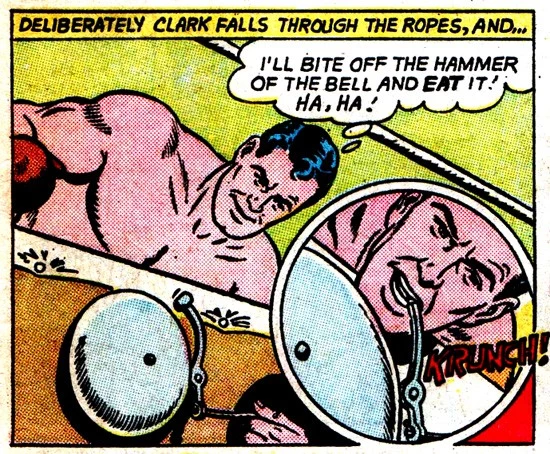
#16. Leo Dorfman and Curt Swan
From "Superman" #168
Of course, not every great panel needs to be some deep revelation about the character. Sometimes I just like it when Superman does ridiculous things.
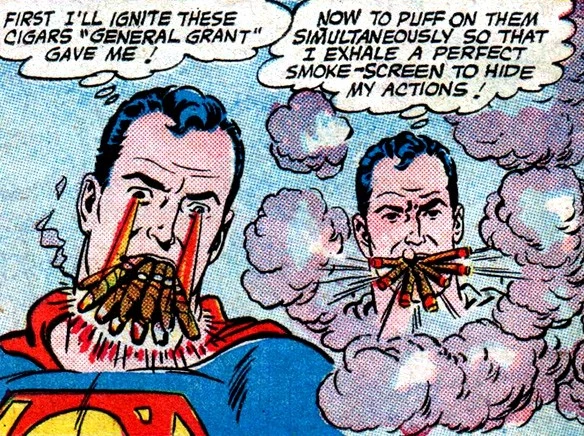
#15. Robert Bernstein and Al Plastino
From "Superman" #163
And sometimes I like it when Superman does ridiculous things that set an absolutely horrible example for children.
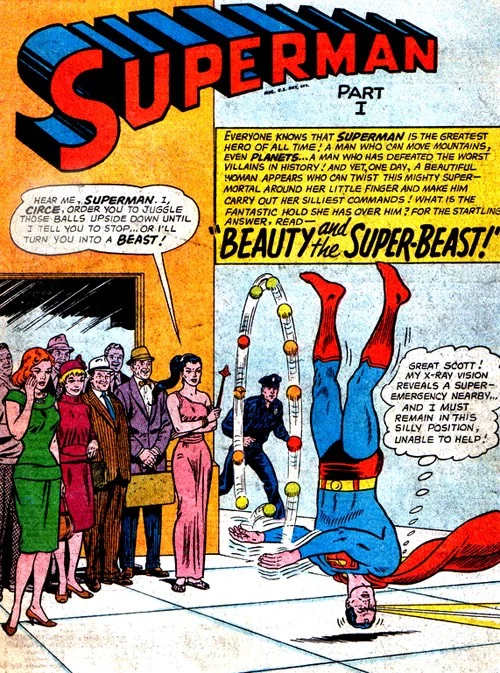
#14. Robert Bernstein and Curt Swan
From "Superman" #165
If the last three panels have taught you anything, it's that Silver Age Superman was indeed as crazy as everyone says. But beyond the obvious charm and hilarity of seeing Superman bouncing upside down on his head while juggling and using his X-Ray vision, there's the key fact of these issues: With these stories, the creators hadn't just made a Superman who was extremely powerful and did goofy stuff, but a Superman who had the time to do all this stuff, because his very presence had essentially put an end to crime and suffering. They had realized that with all his power and morality, Superman would outlive his own usefulness, which meant that he was a guy who had time to keep a giant diary in a house he built at the North Pole, or play jokes on his friends, or get himself into bizarre situations where he had to do upside-down street juggling. Plus, with the realization that there was nothing that could really present a challenge to him, the focus of the stories shifted to making the readers want to know what the heck is going on.
A lot of people don't like that aspect of Superman -- and I totally understand their view and agree that it wasn't really sustainable with the changing landscape of comics -- but I love that stuff.

#13. Jeph Loeb and Tim Sale
From: "Superman For All Seasons" #1
Another benefit of that Silver Age Legacy? While there is an upper limit, the studied silliness of the past means that you can get away with having Superman say things that would be unforgivably cheesy from any other character. Of course, it doesn't hurt if you've got some gorgeous artwork from Tim Sale backing it up, either.
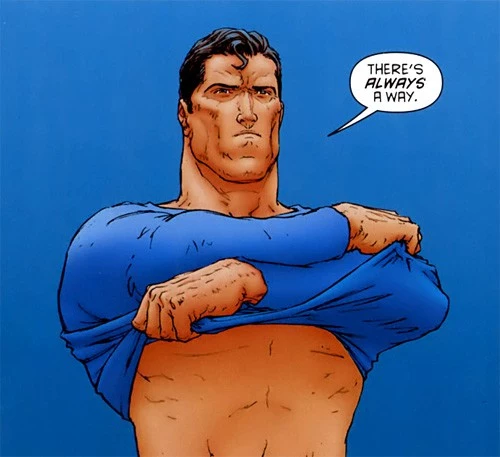
#12. Grant Morrison and Frank Quitely
From "All Star Superman" #11
I don't have the love for Shirtless Superman that I do for Shirtless Batman, but this panel's just great. The simple high concept of Superman's world view aside, Frank Quitely does one of the best faces of his career. That is a man who may be about to die -- the storyline of "All Star Superman," for those of you who don't know, is that Superman is fatally poisoned in the first issue -- but he's also a man with work to do, setting his jaw and getting ready to go save the world. Again.
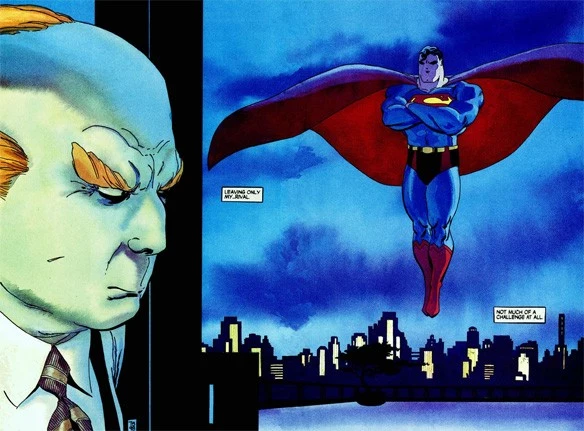
#11. Jeph Loeb and Tim Sale
From: "Superman For All Seasons" #3
"Superman for All Seasons" is the best comic Jeph Loeb an Tim Sale have done together, and this massive panel (a double-page spread) is a great example of why. Just the craftsmanship alone in creating the contrast between Superman and Lex Luthor, the way that Superman's just there, watching, serving as a reminder that he's going to do all he can to stop him is fantastic.
If you can't make out the text, it's narration from Lex: "Leaving only my rival. Not much of a challenge at all." It's a great summary of Lex: Even a guy floating outside his window is, not unlike male pattern baldness, a mere obstacle to be overcome.
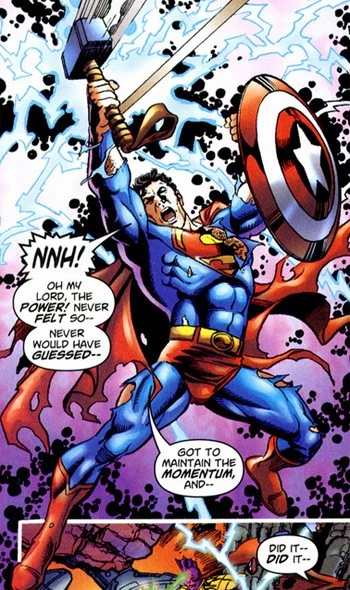
#10. Kurt Busiek and George Perez
From: JLA/Avengers #4
Not gonna lie, guys: There's no deeper meaning to this one than what you see. Superman with Thor's hammer and Captain America's shield. That's awesome.

#9. Denny O'Neil, Curt Swan and Murphy Anderson
From: "Superman" #233
The sequence of Superman eating a piece of Kryptonite is justifiably famous, largely because Swan and Anderson do one of the best faces of their career. I mean, just look at that guy. Some dude literally tried to kill hm, and he decided to make it into a huge joke and is barely containing his laughter. Swan and Anderson's Superman is a guy who just straight up loves his job.

#8. Grant Morrison and Ed McGuinness
From "JLA Classified" #3
Ed McGuinness's clean, almost animated-style artwork is one of the most perfect takes on Superman in modern comics, and his three-issue arc with Grant Morrison makes me utterly depressed that those two never got a fifty-issue run on Justice League. Regardless, he's great, and narrowing it down to just one panel of his was incredibly difficult.
Then I remembered the panel where an angry Superman gives an "I'm not mad, just disappointed" speech to a bunch of talking gorillas, which is basically a love of comics in its purest form.
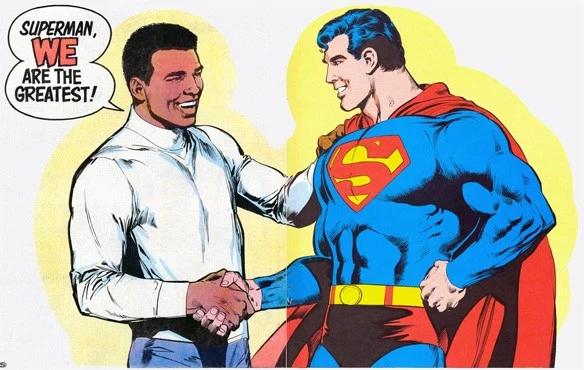
7. Neal Adams
From "Superman vs. Muhammad Ali"
The long out-of-print "Superman vs. Muhammad Ali" is finally getting the deluxe hardcover treatment later this year. This is great news, because as bizarre as the concept might sound -- aliens show up and decide to make Earth's two greatest champions slug it out in the boxing ring or else they'll destroy the planet, which is pretty much the exact plot of "Space Jam" -- it's actually a really great Superman story and a really great Muhammad Ali story. And seeing those two shake hands is just about perfect.
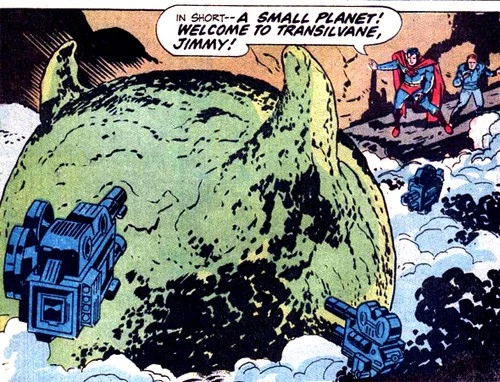
#5. Jack Kirby
From "Superman's Pal Jimmy Olsen" #142
To me, the fact that DC had other artists -- Al Plastino and Murphy Anderson -- re-draw Superman's face during Jack Kirby's tenure as writer/artist of "Jimmy Olsen" to bring him more in line with the company style is one of the most unforgivable sins in comics, even if Kirby got to draw an unedited (and awesome) Man of Steel ten years later in "Super Powers." Still, Kirby with re-drawn faces is still Kirby, as evidenced by this, a scene where Superman takes Jimmy Olsen to a miniaturized world so evil that the planet itself has devil horns, with the casual attitude of "Yep, Planet Transilvane. It must be Tuesday."
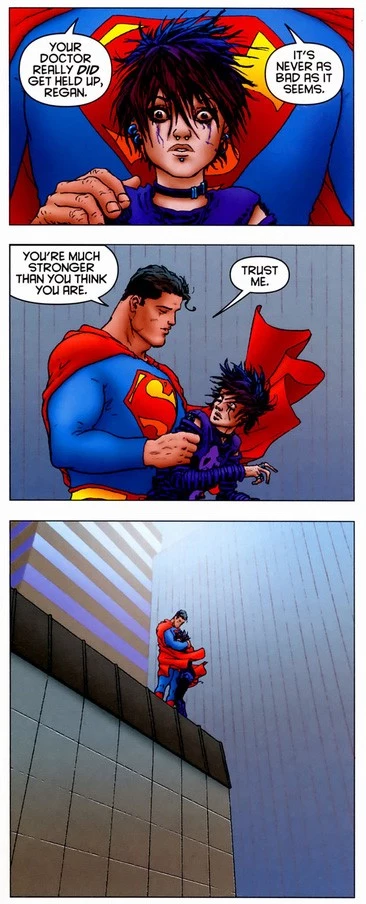
#4, #3, and #2: Grant Morrison and Frank Quitely
From: "All Star Superman" #10
I know I said I was only going to focus on single panels rather than sequences, but what's the point of making my own rules if I don't also get to break them every now and then? Besides, as good as these panels work in sequence, it was impossible for me to choose between them because they're each so perfect. The way that Superman stops a girl from killing herself just by placing a hand on her shoulder, the way that he tells her that she can make it through this, the fact that he takes the time to comfort her with a hug even in the midst of everything else he has to deal with in his day-to-day mission of saving the world; they're all just beautiful moments.
And together, they make an incredible sequence that cuts to what's so great about Superman as a metaphor: There's no worrying about whether or not he's lost touch, he just knows what to do. He shows up when someone needs him, taking the time not just to save a life, but to make it better. These are, without question, my favorite Superman panels in decades.
So what's better than that?
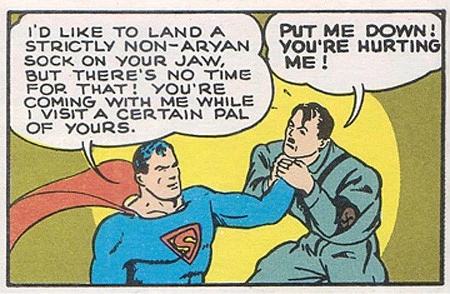
#1. Jerry Siegel and Joe Shuster
From "LOOK Magazine," February 17, 1940
A "strictly non-Aryan" Superman jacking up Hitler. 'Nuff said.
More From ComicsAlliance



